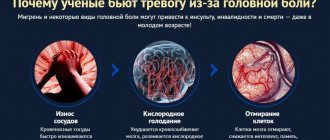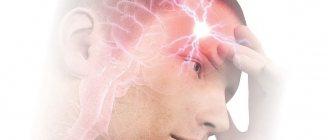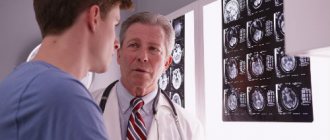Classification of noise in the head and ears
Due to the variety of noise variants, they were classified - combined into groups, common according to the causes of occurrence or characteristics of the course of the disease.
EPFowler (1947) identified two types of tinnitus:
- objective, or vibrator (occurs as a result of vibrations of any parts of the body, exists in reality, can be recorded using a phonendoscope or the use of other diagnostic methods);
- subjective, or non-vibratory (felt by a person, but does not occur in reality, the source of the hum in real life is absent; it cannot be assessed from the outside; it is also called the term “tinnitus”).
In their practice, doctors use a classification of noise based on its cause and distinguish:
- noise of the external, middle ear;
- muscular;
- vascular;
- central;
- peripheral noise.
Shpidonov Gennady Stanislavovich
Neurologist
Rostov State Medical University (neurology)
10 years of experience
Depending on the quality characteristics, the following are distinguished:
- one-sided or two-sided;
- pulsating or monotonous;
- arising from time to time or present constantly;
- low-frequency hum or high-frequency squeak, ringing;
- barely noticeable or strong, intense noise.
Causes
Noises in a person’s head are not always a symptom of pathology. Many sounds arise in our body during its life - during blood flow, joint movement, contraction and relaxation of muscles. They are masked by other sounds present around us and seem invisible to us, and in conditions of complete silence we can pay attention to them.
However, in most situations, extraneous noise, humming and other sounds in the head or ears are a sign of a pathological condition and a reason to contact a specialist.
Vibrator noise is caused by:
- diseases of the temporomandibular joint;
- neuromuscular diseases (gap of the auditory tube, myoclonus of the muscles of the soft palate, middle ear);
- changes in blood vessels (heart valve defects, narrowing of arteries, problems with veins, arteriovenous shunts).
Subjective noise may be based on:
- metabolic disorders (diabetes mellitus, thyrotoxicosis, hyperglycemia, hypoglycemia, atherosclerosis);
- brain tumors;
- neuroma of the VIII pair of cranial nerves;
- diseases of the hearing organ (cerumen plug, otitis, sensorineural hearing loss, labyrinthitis, neoplasms, Meniere's disease, trauma);
- damage by toxic substances (medicines that have a toxic effect on the organ of hearing, methyl alcohol and others);
- diseases of the spine (degenerative-dystrophic changes, instability and others);
- neurological diseases (acute and chronic cerebrovascular accidents, multiple sclerosis, neurocirculatory (vegetative-vascular) dystonia);
- hypertonic disease;
- mental disorders (neurasthenia and other neurotic disorders, depression, schizophrenia);
- exposure to noise and vibration in production;
- traumatic brain injuries (bruises, contusions).
Shpidonov Gennady Stanislavovich
Neurologist
Rostov State Medical University (neurology)
10 years of experience
Rumble in my head
It can also be normal if it appears when a person is in a noisy environment (on a street with active traffic, in a crowded place, in a noisy industry) and after returning to a quiet place, it gradually goes away within two hours. Sometimes it appears as a side effect of a number of medications - antidepressants, anticancer drugs, some antibiotics and NSAIDs. It can also occur in the postoperative period during operations on the organ of hearing - in this situation it is a consequence of intervention in the apparatus that conducts sounds, and after a while it goes away on its own.
Dangerous symptoms
There are a number of signs indicating the development of a life-threatening disease. If they appear, you should consult a doctor immediately:
- A sharp increase in body temperature.
- Numbness in one arm.
- Permanent weakness.
- The emergence of photophobia.
- The veil is accompanied by “floaters” before the eyes, which do not disappear for several minutes.
Almost all of the listed symptoms are characteristic of an acute circulatory disorder or an acute infectious process.
Diagnosis and treatment of noise in the head
When this unpleasant symptom appears, you should not waste time doing self-diagnosis, try to cope with it yourself, or hope that “it will pass.” The correct decision for the patient is to seek help from a specialist.
Diagnosis of diseases accompanied by noise in the head is carried out by doctors of various profiles - therapists, otolaryngologists, neurologists, psychotherapists/psychiatrists. But most often, patients with such a problem turn first to a neurologist.
First of all, the doctor’s task is to specify the noise, to understand what exactly the patient feels - a high-frequency squeak, ringing, buzzing, buzzing or hum, one- or two-sided, accompanied by pulsation or not; clarify the intensity of sensations and the symptoms that could accompany them. If the patient does not tell him himself, the doctor will ask leading questions about whether there is hearing loss, congestion in the ears, headache (usually occipital) pain, a tendency to increase or decrease blood pressure, find out what somatic diseases the person seeking his appointment suffers from. Human. Based on these data, the specialist will suggest what type of tinnitus he is dealing with - objective or subjective. Then he will conduct an objective examination - examine the organ of hearing and perform a number of tests necessary to make a diagnosis.
Shpidonov Gennady Stanislavovich
Neurologist
Rostov State Medical University (neurology)
10 years of experience
At the end of this diagnostic stage, the neurologist will make a preliminary diagnosis (or several putative diagnoses) and prescribe further examination to clarify it, in particular:
- general blood and urine analysis;
- blood biochemistry (lipidogram, coagulogram, ferritin);
- duplex or triplex scanning of neck vessels;
- MRI of the brain or cervical spine;
- consultation with an ENT doctor.
The scope of examinations is determined individually, depending on the specific clinical situation.
If a somatic doctor has not established the cause of noise in the head, he will assume the psychogenic nature of this condition and recommend that the patient consult a psychiatrist or psychotherapist. The specialist will have a targeted conversation with the patient, find out what complaints he has, focusing on feelings of anxiety or fear, decreased mood, especially in the morning, sleep disturbances, severe weakness, palpitations, sudden fluctuations in blood pressure, and will clarify whether this condition is permanent or temporary, not Is it related to stress? If a patient is suspected of neurosis, psychosomatic disorder or depression, the doctor will conduct a series of tests to clarify the diagnosis.
Only after the diagnosis has been established is it recommended to begin treatment for noise in the ear and head.
Medicines for noise in the head and ears
Conservative therapy often helps to cope with this symptom. Depending on the manifestation of which disease the noise is, the patient may be prescribed medications from the following groups:
- antibacterial, anti-inflammatory drugs (for infectious and inflammatory diseases of the ear);
- vascular drugs (improve blood circulation, nutrition of brain cells, dilate blood vessels);
- nootropics (improves metabolic processes in the cells of the nervous system);
- B vitamins (improve trophism of nervous tissue);
- trimetazidine (nourishes the heart muscle);
- iron supplements (if the noise is based on iron deficiency anemia);
- betahistine (for noise due to increased pressure in the cochlear labyrinth);
- antidepressants, anti-anxiety drugs, antipsychotics (if the pathology is psychogenic);
- sedatives, hypnotics – if the patient complains, it is not the inability to sleep;
- medications containing caffeine (for a tendency to low blood pressure, severe weakness and other symptoms of asthenia).
If the cause of the disease is cerumen, the doctor will wash it out of the ear and the noise will disappear.
Surgery
With confirmed damage to the autonomic nervous system, non-vibratory tinnitus can be eliminated by surgical intervention in the area of the nerves of the tympanic cavity or cervical sympathetic nodes.
Surgery on damaged structures of the tympanic cavity or cochlea will help get rid of objective noise.
Other treatment methods
As auxiliary methods of therapy, the patient may be prescribed:
- wearing a hearing aid, electrical stimulation of the auditory nerve (with decreased hearing acuity);
- physical therapy;
- massage;
- physiotherapy;
- psychotherapy.
What to do?
It is almost impossible to independently determine the causes of frequent attacks of dizziness. Therefore, those who regularly experience vertigo are advised to go to an appointment with a therapist, or a neurologist. The specialist will carefully examine the patient’s complaints and prescribe diagnostic tests. If necessary, the doctor will refer the patient for consultations with an ENT specialist, an ophthalmologist, a cardiologist, or an endocrinologist.
To identify the causes of vertigo, the patient may be prescribed the following tests:
- Neurological tests. They allow you to assess the functionality of the vestibular apparatus.
- MRI or CT. Such brain studies reveal various disorders (hemorrhages, tumors, vascular pathologies).
- Ultrasound Doppler. Using Doppler ultrasound, the condition of the vessels of the head and neck is studied.
- Audiometry. Diagnostics allows us to assess hearing function.
- EEG. To study the activity of the cerebral cortex, the doctor will prescribe electroencephalography.
To quickly cope with dizziness (of course, if it is not caused by dangerous reasons), you can sit on any surface, relax a little and take 5-6 deep breaths. Be sure to open the window (if you are indoors) to provide fresh air. If the causes of vertigo are harmless, then such actions are quite enough for the dizziness to disappear without a trace.
How to relieve an attack of severe noise in the head and ears
Treatment for severe head noise depends on its cause. If it occurs suddenly, is intense, is accompanied by vomiting, severe pain, heaviness in the head, dizziness, significantly worsens the person’s condition, and it is dangerous to fight it on your own - it is important to call an ambulance as quickly as possible.
Shpidonov Gennady Stanislavovich
Neurologist
Rostov State Medical University (neurology)
10 years of experience
If it is a sign of chronic pathology, is already familiar to you, and is not the first time it has appeared, you can try to cope with the noise using the following self-help methods:
- taking a relaxing bath;
- a full eight-hour sleep (on a comfortable mattress with a comfortable pillow, in a dark room, in silence);
- physical activity (such as yoga or jogging in the park);
- listening to calm music.
Some people are helped to eliminate noise by so-called “masking” - listening to a pleasant, soothing sound (such as the splashing of waves, the murmur of a stream, the chirping of birds) directly in nature, using an audio recording or a special device.
Prevention of pulsating noise in the head
The noise that occurs in the pulse rhythm is characteristic of vascular pathology of the brain. It can be prevented by a person’s attentive attitude to his health throughout his life - quitting smoking, regular exercise, adherence to a work and rest schedule, a nutritious, balanced diet, blood pressure control, timely medical examinations and treatment of vascular diseases that have arisen in the early stages. If these diseases already exist, following the recommendations described above will help reduce the intensity of the hum, alleviate it, which will improve the person’s quality of life.
If pulsating noise appears in the head only in certain situations (under stress, when working at the computer), its prevention will be to minimize exposure to situations that provoke deterioration of the condition.
Associated symptoms
Very rarely, the veil appears without accompanying symptoms, which will help to recognize which disease caused the illness. The clinical picture of these diseases is accompanied by symptoms:
Glaucoma:
- Sharp pain in the eye and head from the affected eye.
- Vision deteriorates sharply, sometimes so much that the patient cannot see the outlines of objects, only able to distinguish light.
- A veil appears before the eye.
- Nausea, often leading to vomiting.
- Redness of the eye.
Corneal damage:
- Tearing that does not stop for a long time.
- Sensation of a foreign body in the eye.
- Pain in the eyes, worse in the light.
- Decreased visual acuity.
Migraine:
- Pain that occurs in only one part of the head.
- The pain is throbbing or aching.
- Severe discomfort when exposed to loud noises, strong smells, or bright lights.
- Pain relief in darkness and silence.
- Nausea.
The appearance of a veil before the eyes may be accompanied by light flashes, spasmodic headaches, and glare. If unpleasant symptoms appear, you should consult an ophthalmologist. Even if you know what exactly triggered the attack. It is impossible to choose effective treatment on your own, especially for diseases such as cataracts and glaucoma.










